Adaptation of microplate-based respirometry for hippocampal slices and analysis of respiratory capacity
- PMID: 21520220
- PMCID: PMC3144988
- DOI: 10.1002/jnr.22650
Adaptation of microplate-based respirometry for hippocampal slices and analysis of respiratory capacity
Abstract
Multiple neurodegenerative disorders are associated with altered mitochondrial bioenergetics. Although mitochondrial O(2) consumption is frequently measured in isolated mitochondria, isolated synaptic nerve terminals (synaptosomes), or cultured cells, the absence of mature brain circuitry is a remaining limitation. Here we describe the development of a method that adapts the Seahorse Extracellular Flux Analyzer (XF24) for the microplate-based measurement of hippocampal slice O(2) consumption. As a first evaluation of the technique, we compared whole-slice bioenergetics with previous measurements made with synaptosomes or cultured neurons. We found that mitochondrial respiratory capacity and O(2) consumption coupled to ATP synthesis could be estimated in cultured or acute hippocampal slices with preserved neural architecture. Mouse organotypic hippocampal slices oxidizing glucose displayed mitochondrial O(2) consumption that was well coupled, as determined by the sensitivity to the ATP synthase inhibitor oligomycin. However, stimulation of respiration by uncoupler was modest (<120% of basal respiration) compared with previous measurements in cells or synaptosomes, though enhanced slightly (to ∼150% of basal respiration) by acute addition of the mitochondrial complex I-linked substrate pyruvate. These findings suggest a high basal utilization of respiratory capacity in slices and a limitation of glucose-derived substrate for maximal respiration. The improved throughput of microplate-based hippocampal respirometry over traditional O(2) electrode-based methods is conducive to neuroprotective drug screening. When coupled with cell type-specific pharmacology or genetic manipulations, the ability to measure O(2) consumption efficiently from whole slices should advance our understanding of mitochondrial roles in physiology and neuropathology.
Copyright © 2011 Wiley-Liss, Inc.
Figures


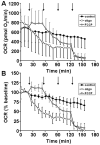
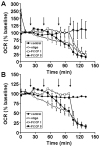
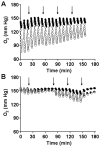

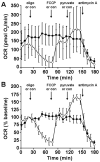
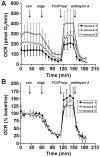
Similar articles
-
Analysis of respiratory capacity in brain tissue preparations: high-resolution respirometry for intact hippocampal slices.Anal Biochem. 2018 Jun 15;551:43-50. doi: 10.1016/j.ab.2018.05.010. Epub 2018 May 17. Anal Biochem. 2018. PMID: 29753719
-
Glucose, Lactate and Glutamine but not Glutamate Support Depolarization-Induced Increased Respiration in Isolated Nerve Terminals.Neurochem Res. 2017 Jan;42(1):191-201. doi: 10.1007/s11064-016-2036-4. Epub 2016 Aug 22. Neurochem Res. 2017. PMID: 27545309
-
Altered mitochondrial oxidative phosphorylation in hippocampal slices of kainate-treated rats.Brain Res. 1999 May 1;826(2):236-42. doi: 10.1016/s0006-8993(99)01279-2. Brain Res. 1999. PMID: 10224301
-
Bioenergetics at low oxygen: dependence of respiration and phosphorylation on oxygen and adenosine diphosphate supply.Respir Physiol. 2001 Nov 15;128(3):277-97. doi: 10.1016/s0034-5687(01)00307-3. Respir Physiol. 2001. PMID: 11718759 Review.
-
Oxygen conformance of cellular respiration. A perspective of mitochondrial physiology.Adv Exp Med Biol. 2003;543:39-55. doi: 10.1007/978-1-4419-8997-0_4. Adv Exp Med Biol. 2003. PMID: 14713113 Review.
Cited by
-
An efficient and high-throughput method for the evaluation of mitochondrial dysfunction in frozen brain samples after traumatic brain injury.Front Mol Biosci. 2024 Jun 5;11:1378536. doi: 10.3389/fmolb.2024.1378536. eCollection 2024. Front Mol Biosci. 2024. PMID: 38983247 Free PMC article.
-
Bioenergetic profiling of zebrafish embryonic development.PLoS One. 2011;6(9):e25652. doi: 10.1371/journal.pone.0025652. Epub 2011 Sep 29. PLoS One. 2011. PMID: 21980518 Free PMC article.
-
Methods for assessing mitochondrial function in diabetes.Diabetes. 2013 Apr;62(4):1041-53. doi: 10.2337/db12-1219. Diabetes. 2013. PMID: 23520284 Free PMC article. Review.
-
Functional mitochondrial analysis in acute brain sections from adult rats reveals mitochondrial dysfunction in a rat model of migraine.Am J Physiol Cell Physiol. 2014 Dec 1;307(11):C1017-30. doi: 10.1152/ajpcell.00332.2013. Epub 2014 Sep 24. Am J Physiol Cell Physiol. 2014. PMID: 25252946 Free PMC article.
-
Mitochondria-related miR-141-3p contributes to mitochondrial dysfunction in HFD-induced obesity by inhibiting PTEN.Sci Rep. 2015 Nov 9;5:16262. doi: 10.1038/srep16262. Sci Rep. 2015. PMID: 26548909 Free PMC article.
References
Publication types
MeSH terms
Substances
Grants and funding
LinkOut - more resources
Full Text Sources
Research Materials

